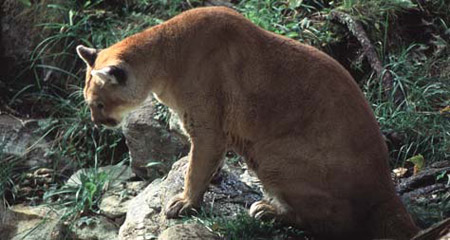Eastern Cougar
Felis concolor
by Jane Krupnick
Updated by Allison Mains, Jim Dean and Colleen Olfenbuttel
North Carolina Wildlife Resources Commission
Classification
Class: Mammalia
Order: Carnivora
Average Size
Length: 6-8 ft., including a long, curving tail.
Height: male 27 in.; female 24 in.
Weight: male 150 lbs.; females 100 lbs.
Food
Deer, elk, porcupines, mice, game birds, fish, slugs, grasshoppers, martens, skunks, raccoons, foxes and other small mammals.
Breeding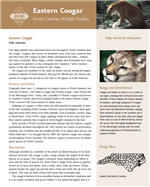
Cougars become sexually mature at 2 or 3 years old, and usually mate in August or spring. Males may mate with several females. On average, females will bear a litter once every 2-3 years.
Young
Called kittens. Cougars weigh 8-16 ozs. when born in litters of 1-6 kittens after a gestation period of 96 days. Their eyes remain closed for 14 days, and they are usually weaned after 4 or 5 weeks. Kittens will stay with their mother for up to 2 years.
Life Expectancy
Average 12 years
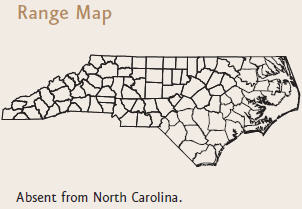 Range and Distribution
Range and Distribution
Cougars are known to cover 20 to 25 miles in one night, marking their territories with urine and piles of feces. Despite the historic declines in numbers, surviving subspecies of cougars are still distributed more widely north and south than any New World mammal, ranging from southern Canada to the southern tip of South America. At one time, they also ranged from coast to coast in North America, but by the 1900s they had largely disappeared east of the Mississippi, leaving only the small confirmed population of Florida panthers in southern Florida.
General Information
Few large animals have generated more lore throughout North Carolina than the cougar. Cougars, also known as mountain lions, were once common here and they have left a legacy of place names throughout the state— indeed, the entire Southeast. Many ridges, creeks, swamps and mountains were long ago named for panthers or the colloquial term “painters,” both common names in this part of the country for the cougar.
All cougars are members of the small cat family and are among the largest predatory animals of North America. Among New World cats, the various subspecies of cougars are second in size only to the jaguar of South America.
History and Status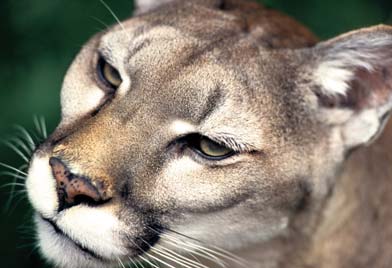
Originally there were 11 subspecies of cougars native to North America, but only two of them— the Eastern cougar and Florida cougar—were found east of the Mississippi River. Today, only a handful of Florida cougars still survive in southern Florida, and most biologists believe the native Eastern cougar (Felis concolor) has been extinct for many years.
Sightings of cougars or their tracks are still reported occasionally in parts of the East, including North Carolina. However, upon investigation, these sightings and tracks often prove to be other animals, such as bobcats, coyotes, dogs, or black bears. Some of the cougar sightings made in recent years may have been captive animals that escaped or were illegally released in the East. Early records of North Carolina mammals indicate that the Eastern cougar’s populations declined throughout the 18th century as a result of persecution, hunting, loss of habitat and the parallel decline of its major prey species, the white-tailed deer. It is thought that by 1900, the Eastern cougar was extirpated throughout North Carolina. The Eastern cougar is protected as an endangered species in North Carolina.
Description
Although classified as a member of the s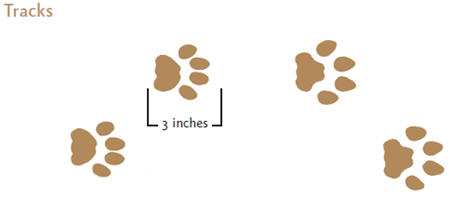 mall cat family because of its skull and eye structure, the cougar is quite a large animal, the largest of all other species in its genus. The cougar’s coloration varies depending on where it lives and the time of season, but most often it ranges from tawny to grayish brown on its back and flanks, with a white chest, belly and throat. Dusky patches border the upper lip and the back of the ears while the tip of its tail is black. The cubs are buff-colored with spots that eventually fade.
mall cat family because of its skull and eye structure, the cougar is quite a large animal, the largest of all other species in its genus. The cougar’s coloration varies depending on where it lives and the time of season, but most often it ranges from tawny to grayish brown on its back and flanks, with a white chest, belly and throat. Dusky patches border the upper lip and the back of the ears while the tip of its tail is black. The cubs are buff-colored with spots that eventually fade.
The cougar is known to be an excellent hunter in all weather conditions and it is an expert swimmer and good climber. It has speed and agility and is a stealthy stalker that hunts by sight and smell. It prefers wild quarry such as deer; however, cougars have been known to eat anything from slugs to horses.
Habitat and Habits
The cougar can survive in a variety of climates and habitats, and is at home in mountains, forests, desert scrub, swamps and jungles. Cougars usually hunt on the ground and depending on where they live and when their prey is active, they may hunt either day or night. When capturing their prey, the cougar stalks, rushes, pounces and then inflicts a bite on the nape of its prey’s neck. After feeding, the cougar may cover the remains and return later to finish the meal.
The male cougar is generally a loner until mating, at which time he pairs with the female for two weeks. Prior to mating, males are very aggressive and may even kill competing males. Although these animals are known to be secretive and quiet, they may let out an eerie scream during the mating period.
People Interactions
Cougars are so secretive that even in parts of the American West where they are still quite common, many people live their entire lives without seeing one. Likewise, danger to humans has been largely exaggerated, and although there have been attacks on people, they are quite rare. A cougar is highly unlikely to attack unless it is cornered or a female cat perceives that there is a threat to her young.
As with most wildlife, the greatest threat to cougars is loss of habitat though human activities. Where cougar populations are stable and sport hunting is permitted under carefully designed regulations, there are no indications that current hunting has a negative impact upon current populations.
NCWRC Interaction: How You Can Help
Though cougars have been extirpated from North Carolina since 1900, the NCWRC still receives reports from the public on sightings of cougars or cougar tracks. Upon investigation, NCWRC biologists have concluded that many reports of cougar sightings or their tracks are misidentification of both domestic and wild animals. Domestic cats and dogs, coyotes, bobcats, and red foxes infected with mange are the most common animals mistaken for cougars. It is possible that some sightings can be attributed to captive cougars that have escaped or been illegally released. During the 1980s, two captive cougars were found feeding at a dumpster in Tyrell County. No tangible evidence exists that wild cougars currently exist in North Carolina.
NCWRC also receives reports of “black panthers.” The only species that fits this description is a leopard and jaguar, which is a spotted cat whose size overlaps with that of the North American cougar, often with spots that are difficult to discern. Jaguars are native to Mexico, Central and South America and range as far north as South Texas, New Mexico and Arizona; no wild jaguars have been reported outside of the southwestern United States. Leopards are native to Africa, Central Asia, India, and China. However, many of their populations are endangered, especially outside of Africa. It is most likely that folks are seeing a black bear or a bobcat in the shadows. As with cougars, it is also possible that it is a captive jaguar or leopard that has escaped or been illegally released.
Link:
To see a cougar in action, go to: https://www.youtube.com/watch?v=UIcqhYezm08
References:
Beebe, B.F. American Lions and Cats (David McKay Co., Inc., 1963).
Denis, Armand. The Cats of the World (Houghton Mifflin Co., 1964).
Hall, E. Raymond. The Mammals of North America (Wiley-Interscience Publication, 1981).
Lee, David S., John B. Funderburg Jr. and Mary K. Clark. A Distributional Survey of North Carolina Mammals. (N.C. Museum of Natural Sciences, 1982).
Russell, J.K. and D.R. Voight. The Encyclopedia of Mammals, ed. D. Macdonald (Facts on File, 1984).
Credits:
Produced by the Division of Conservation Education, Cay Cross–Editor.
Illustrated by J.T. Newman. Other photos by North Carolina Wildlife Resources Commission.

14 March 2012 | Dean, Jim; Krupnick, Jane; Mains, Allison; Olfenbuttel, Colleen
